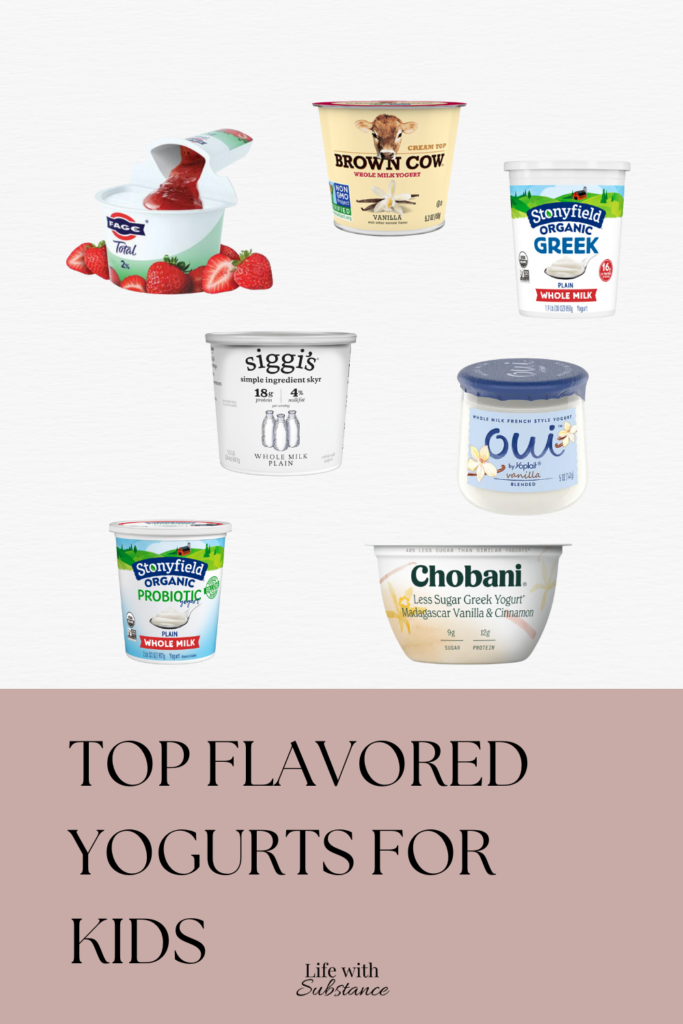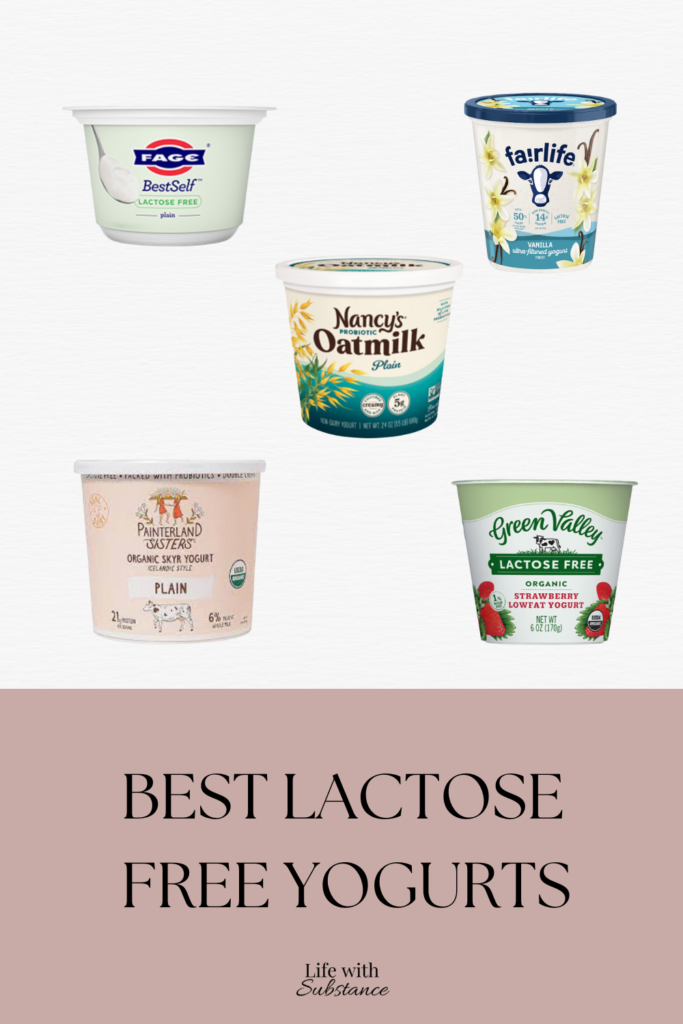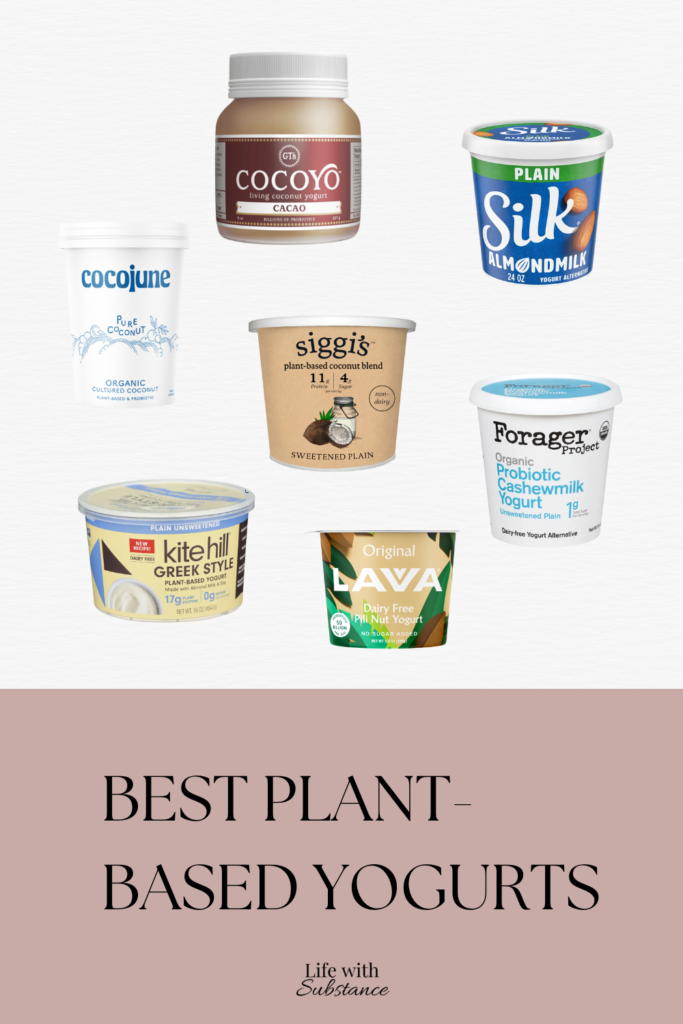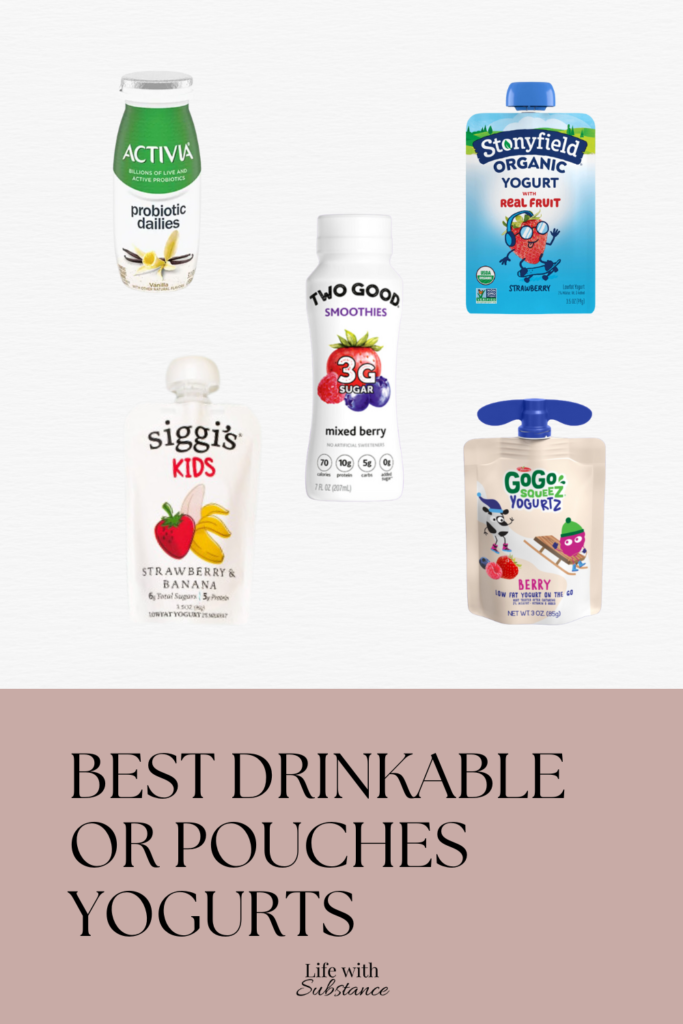This post may contain affiliate links. If you shop from one of our links, we may earn a commission.
Navigating the yogurt aisle can feel like decoding a complex labyrinth. As parents, we know that yogurt is a nutritious option for our kids, but with the large variety of options all advertising different benefits, it can be hard to know which one to pick. But don’t fret! As a pediatric dietitian and mom, I’m here to lend you a hand (or a spoon). Today, we’re on a mission to find the best yogurt for your little ones.
- Understanding the Importance of Yogurt for Kids
- How to Choose the Best Yogurt for Your Kid
- Added Sugar Versus Natural Sugar
- Protein Content
- Probiotics and Their Role in Kids’ Yogurts
- Choosing Between Flavored and Plain Yogurt
- Top Kid-Friendly Yogurt Brands
- Incorporating Yogurt into Your Kids’ Diet
- When to Begin Offering Yogurt to Little Ones
- In Summary
Understanding the Importance of Yogurt for Kids
Ever wondered why your pediatrician keeps singing praises of yogurt? It’s not just because it tastes great! Believe it or not, yogurt is like a superhero in disguise for your kids. It’s packed with a variety of essential nutrients – think protein, calcium, carbohydrates, phosphorus, potassium, vitamin A, vitamin B12, and in many cases, essential probiotics. All these nutrients join hands to fuel your kid’s growth and development. And those probiotics? They’re like little helpers for your child’s digestive system, ensuring it stays healthy and balanced. So, if you thought yogurt was just another item on your grocery list, think again!
How to Choose the Best Yogurt for Your Kid
Conquering the yogurt aisle is no small feat, so let’s break this down to make choosing the best yogurt for your kid simple and quick. Those animated characters on the packaging may try to confuse you from picking the best choice. From fun yogurt tubes to drinks to cute yogurt jars, there is a slew of different types of yogurt to choose from. With a little knowledge and savvy, you’ll be the yogi of the yogurt aisle in no time.
Okay, roll up those sleeves – it’s time to dive into the world of nutrition labels. Think of it as a treasure hunt, where the loot is the best yogurt for your kids. Here’s the magic formula: aim for low sugar and high protein, and keep an eagle eye out for yogurts boasting those superstar “live cultures” (we’ll delve deeper into this in a bit).

Added Sugar Versus Natural Sugar
Let’s start with how to decipher between added sugar and natural sugar. This is where I tend to get the most questions. A lot of parents believe yogurt is not a healthy option for their kids because “of all the sugar.” I hear you, that part can be confusing. But keep in mind that some of the sugar comes from naturally occurring sources, such as dairy and fruit. Milk has a naturally occurring sugar called lactose. This is also the sugar that is found in breast milk and does not need to be avoided for your child.
However, many of the flavored yogurts contain added sugar. Added sugar can be found on the nutrition label under “carbohydrates”. Don’t worry so much about looking at the carbohydrates, but rather the “added sugar” section listed below. The goal is to have less than 10 grams of added sugar per serving size.
Plain yogurt is going to have the least amount of added sugar. After that, the yogurts that will have the least to highest amounts of added sugar are flavored or mixed yogurts, fruit on the bottom, then yogurts with optional stir-ins. Yogurt tubes can be fairly high in sugar, however, that doesn’t mean that they can’t be offered. Kids love this option and they are convenient to grab and eat on the go or pack in lunches while still providing many important nutrients. Pro tip: my kids love eating them frozen. It’s like an ice cream treat!
Plain yogurt is recommended for babies and young toddlers. However, you can easily adjust the flavor or sweetness by mixing it in with fruit purees or oatmeal. After the age of 2, you may introduce more of the flavored yogurts.
Protein Content
One of the many benefits of yogurt that most people appreciate is the amount of protein it provides. When looking at nutrition labels, aim for at least 4 grams of protein per serving. Many Greek yogurts provide 8+ grams of protein per serving. If your family follows a vegan diet, you may have difficulty finding a higher-protein yogurt. Instead, you can mix in chia seeds or hemp seeds to enhance the protein in dairy-free yogurts.
Probiotics and Their Role in Kids’ Yogurts
Let’s dive into the wonderful world of probiotics. Picture them as the tiny superheroes of the gut, coming to the rescue of your little one’s digestive system. Not all yogurts have these mini marvels, but those that do proudly display “live cultures” or “active cultures” on their labels.
Are you feeling overwhelmed by the fancy lingo? No worries, let’s simplify. Keep an eye out for Lactobacillus and Bifidobacterium – these two are the dynamic duo of the probiotic universe, akin to Batman and Robin if you will. They tirelessly work to maintain good gut health and boost their immune system. Plus, rumor has it, that they might even help with conditions like diarrhea and lactose intolerance.
But remember, just because a yogurt mentions “cultures” doesn’t mean it’s the same as “live” or “active” cultures. Think of it like this: you wouldn’t be thrilled with a superhero action figure when you could have the actual superhero, right? It’s the same principle here. So next time you’re in the yogurt aisle, don’t just skim through the labels; dig a little deeper. It’s worth it, trust me. Your little ones and their tummies will thank you.
Check out this post to learn if you should supplement your child’s diet with probiotics.
Choosing Between Flavored and Plain Yogurt
Listen, it’s the battle of the century: flavored versus plain yogurt. I know, I know, those fruit-infused varieties can be pretty tempting, especially to the discerning palate of a five-year-old. If your child prefers yogurt options that are higher in sugar, don’t stress.
First off, just because the yogurt has more sugar in it, it doesn’t automatically mean that it is “bad” or “unhealthy.” It still provides many health benefits such as calcium, protein, fat, carbohydrates, and a variety of other nutrients. I highly recommend you avoid labeling those foods as such as it can create guilt or shame for choosing that option. Which can also lead to an unhealthy relationship with food.
Alright, let’s talk about the elephant in the yogurt aisle – sugar. While yogurt is a nutritional powerhouse, some varieties can be a little too generous with the sweet stuff. But don’t despair; there are some crafty ways to make it healthier without sacrificing taste. Let’s do this!

First off, consider swapping flavored yogurts for plain ones. Remember, we talked about this earlier? Flavored yogurts often come with a side of added sugars, which we’re trying to dodge. So, grab that plain yogurt and use nature’s sweetness instead. Fresh fruits, a drizzle of honey, or even a sprinkle of cinnamon can do the trick.
Don’t be afraid to get creative with your mix-ins. Ever tried a dash of vanilla extract or a sprinkle of unsweetened cocoa powder? It’s like a mini adventure for your taste buds, minus the sugar rush.
If you’re using yogurt in cooking or baking, see if you can reduce or eliminate other sources of sugar in the recipe. Plain flavor is also a great option in place of sour cream.
Options to mix in:
- Real fruit such as juicy berries or slices of fresh banana
- Pureed pumpkin
- All fruit jams or preserves
- Drizzle honey (avoid for infants under the age of 1) or maple syrup
- Peanut butter or nut butter
- Baby food fruit purees
- Chia jam
Not only will you have full control over the sugar content by modifying your regular yogurt, but you can also unleash your creativity. Reusable pouches, such as this one, are also a great way to make yogurt more enticing for little ones.
Finally, if your kids are hooked on sweetened yogurts, don’t go cold turkey on them. Gradually decrease the amount of sugar over time. It’s like tiptoeing past a sleeping dragon – you want to make the change so subtly, they won’t even notice. Keep in mind that if your child will only eat the higher sugar-containing yogurts, that’s okay. It is still a good option and provides plenty of other nutrients.
So there you have it, sugar-slaying tips to help you navigate the dairy aisle like a pro. Your mission, should you choose to accept it, is to boldly go where few parents have gone before – toward the plain yogurt section. Trust me, it’s an adventure worth embarking on!
Top Kid-Friendly Yogurt Brands
Are you ready to step up your yogurt game? I’m about to drop some names that’ll make your next trip down the yogurt aisle a breeze.
Let me introduce the ‘A’ listers of the yogurt world. They’re like the cool kids at school who are not only popular but also excel in academics. This is not an exhaustive list, but most highly recommended and a great place to start.
Top Flavored Yogurts for Kids – Listed in no specific order
- Siggi’s – They are known for their Icelandic-style yogurt that’s high in protein and low in sugar. Just what we’ve been looking for, right?
- Chobani less sugar or zero sugar options– Their Greek yogurts are not only creamy and delicious but they’re also lower in sugar than most other brands.
- Stonyfield Organic – These guys make great yogurts with minimal ingredients.
- Fage Total 2% Strawberry
- Brown Cow Vanilla Whole Milk Yogurt
- Oui Whole Milk Vanilla Yogurt – This French-style yogurt is made with whole milk and comes in an adorable glass jar. Oui yogurts use simple ingredients with no artificial flavors. They also have dairy-free options.
- Stonyfield Probiotic Whole Milk Yogurt – This whole milk option is great for infants who are just starting solids and is a good source of probiotics.

Best Lactose-Free Yogurts
Lactose-free yogurt is still dairy-based but it does not contain the milk sugar, lactose. This is because they add an enzyme called lactase that helps to break down lactose. Lactose-free yogurts that are made with dairy products generally have a higher protein content and have a more creamy mouth-feel compared to plant-based yogurts.
- Fage Lactose-Free
- Painterland Sisters Plain Skyr
- Nancy’s Probiotic Oat-Milk, Plain
- Green Valley Lactose-Free
- Fairlife

Best Plant-Based Yogurts
Plant-based yogurts are made with nut, seed, or soy “milk”. This essentially means that they do not contain any lactose. Keep in mind that individuals who choose to follow a vegan diet have to be more aware of finding adequate sources of calcium and vitamin D. However, vegan yogurts are all over the board as far as their nutrition profile. Some have the same amount of calcium and vitamin D as the typical cow’s milk yogurt, while others have just one nutrient or none at all. These are factors to take into consideration when choosing a plant-based yogurt for little ones.
- Cocojune Plain
- GT’s Cocoyo Living Coconut Yogurt Cacao
- Siggi’s Sweetened Plain Plant-Based Coconut
- Kite Hill Greek Style Plain
- Silk Almondmilk Yogurt Alternative, Plain
- Forager Project Probiotic Cashewmilk
- Lava Pili Nut Yogurt

Best Drinkable or Pouches Yogurts
- Activia Probiotic Dailies
- Two Good Smoothies
- Siggi’s Yogurt Pouch
- Stonyfield Organic Kid’s Whole Milk Yogurt Pouches
- GoGo Squeez Yogurtz

Incorporating Yogurt into Your Kids’ Diet
Alright, we’ve made it through the trenches of the yogurt aisle, we’ve deciphered nutrition labels, and we’ve even transformed into DIY flavor wizards. Now, let’s chat about fun and delicious ways to incorporate yogurt into your child’s meals and snacks.
Yogurt isn’t just for breakfast or a quick grab-and-go snack, my friends. A fan favorite in my home is blending a creamy, probiotic-rich smoothie on a warm afternoon. Homemade yogurt-based popsicles are super easy, have fewer grams of sugar than a typical popsicle, and kids love them.

Yogurt-infused dip for fresh veggies is a simple way to sneak in some added nutrition into their diet. It can even play an undercover agent in pasta sauces, bringing a surprise protein boost to dinner.
Let’s take it up a notch. Have you ever considered turning snack time into a creative session? Grab your artist’s palette (or a fancy dish will do), fill it with colorful fresh fruits, and let your kids paint their plain yogurt canvas.
Incorporating it into your kids’ diet is like unboxing a surprise toy – you never know what amazing creation you’ll end up with. But hey, no pressure, just be open to experimentation and have a blast with it. After all, the journey of exploring and enjoying nutritious food with your little ones is what makes the parenting adventure truly memorable.
When to Begin Offering Yogurt to Little Ones
Now, let’s get down to the big question: when can you start introducing this to your infant? Drumroll, please…you can start as early as six months! Yes, you heard it right. As soon as your little explorers are ready to embark on their gastronomic adventure beyond breastmilk or formula, yogurt can be their trusty sidekick.
Start with plain whole milk yogurt, the mild, unsweetened superhero we’ve been praising all along. Keep in mind that cow’s milk to drink is difficult on an infant’s tummy, but dairy-based yogurt is often well tolerated. Its gentle flavor is not only perfect for your child’s developing taste buds but also a versatile culinary chameleon. You can serve it as is, mix it with pureed fruits or veggies, or even use it as a creamy base for your baby’s first cereal. Plus, it’s brimming with vital nutrients needed for your baby’s growth and development.
Remember, as with any new food, start small and watch for any allergic reactions. Once your kid gives the green signal, feel free to make yogurt a regular guest at meal times. Who knew introducing your baby to their first dairy product could be so simple and stress-free?
In Summary
So there you have it, the yogi’s guide to the yogurt aisle. Give these brands a try and find your family’s new favorite. But don’t just take my word for it, hit the grocery store and see for yourself. Your little one might just find their new favorite snack. And who knows, you might just find yourself reaching for a cup (or two) as well!

